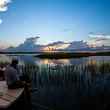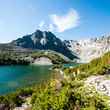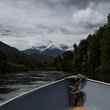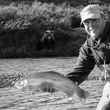This year marks the 150th anniversary of the Peshtigo Fire, the deadliest wildfire in American history and an event that continues to exert a compelling grip on my imagination. There are any number of reasons for this but the one I keep coming back to is that the landscape that was burned—the watersheds of the Peshtigo and Menominee rivers, essentially—has been at the center of my pursuits with fly rods, bird dogs, and shotguns for close to 40 years. It’s where I’ve crashed around after grouse and woodcock, flogged the water for brookies, browns, and smallmouth, and—with apologies to Tom McGuane—generally done my level best to ruin my life for sport.
Despite its grisly claim to fame, the Peshtigo Fire remains relatively little-known, so much so that it’s sometimes referred to as “the forgotten fire.” Here’s a look back at that singularly horrific event—and at its complicated aftermath.
Several days after the conflagration that came to be known as the Peshtigo Fire had incinerated more than a million acres of northeastern Wisconsin and the southernmost lobe of Michigan’s Upper Peninsula, a small party of loggers searched the smoking wasteland near their former camp. They entertained no hope of finding survivors; they simply wanted to see if they could locate the remains of any of their friends.
Suddenly, as they passed beneath a blackened pine, a body they recognized as a camp foreman crashed down at their feet.
“Why in the world did he climb that tree?,” someone asked. “Didn’t he know that fire burns upward?”
More Like This
“What difference did it make?,” another man replied. “It was hell on earth that night … and hell in heaven, too.”
The Chicago Fire may or may not have been the result of Mrs. O’Leary’s cow kicking over a lantern. But that famous blaze—fueled, in a piece of terrible irony, by buildings composed of pine from northern Wisconsin—was a mere weenie roast compared to the fire that, on the very same night, devastated the landscape where much of that pine had been cut. One hundred and fifty years later, it still ranks, by a wide margin, as the deadliest wildfire in American history.
A plaque that stands among the somber stones in the Peshtigo Fire Cemetery offers a starkly incisive summation of that horrific event:
On the night of October 8, 1871, Peshtigo, a booming city of 1,700 people, was wiped out of existence in the greatest forest fire disaster in American history.
Loss of life and even property in the great fire occurring the same night in Chicago did not match the death and destruction visited upon northeastern Wisconsin during the same dreadful hours.
The town of Peshtigo was centered around a woodenware factory, the largest in the country. Every building in the community was lost. The tornado of fire claimed at least 800 lives. Many of the victims lie here. The memory of 350 unidentified men, women, and children is preserved in a nearby mass grave.
While Peshtigo and a trio of outlying hamlets known as the Sugar Bushes were at the epicenter of the catastrophe, the fire, borne aloft on gale-force winds, leapt Green Bay to claim hundreds of lives on the lower Door Peninsula of Wisconsin as well. One settlement there, Williamsonville, was so comprehensively obliterated that for decades historians argued over its exact location.
There were also at least 60 logging camps located within the fire’s boundaries, along with an unknown number of remote farmsteads, camps belonging to hunters and trappers, etc. It wasn’t wilderness, exactly, but it was a far cry from what most of us understand as civilization. So in addition to the hundreds of victims whose remains could not be identified, many more who found themselves in the path of the inferno simply vanished without a trace.
The point being that no one really knows how many people died in the Peshtigo Fire. The “usual” estimate is 1,200, but the authors of Firestorm at Peshtigo, the most deeply researched of the several books devoted to the subject, believe that the actual toll is closer to 2,500.

By any reckoning, it ranks as the deadliest wildfire in American history. For comparison’s sake, the more famous Chicago Fire, which, again, occurred on the same night and whose flames were fanned by the same terrific winds, claimed at most 300 lives.
The total area burned by the Peshtigo Fire was 2,400 square miles—more than twice the land area of the state of Rhode Island—while the property damage was conservatively estimated at $5 million, a staggering sum for the time. As many as two billion trees were destroyed, along with an incalculable quantity of wildlife (the burnt woods were said to be littered with the carcasses of deer) and countless head of cattle, horses, and other livestock. As late as May of the following year, human remains continued to be discovered—not only in the hinterlands but even within the city limits of Peshtigo.
Throughout the summer and early fall of 1871, much of the northern United States was parched by drought. The fire hazard was extreme from the Dakotas to the Alleghenies, but what made northeastern Wisconsin particularly vulnerable were the immense piles of woody debris, commonly known as “slash,” left behind in the wake of the rapacious logging practices of the era. A single slash pile might cover an entire quarter-section—160 acres—and rise to a height of 16 feet.
Largely composed of pine tops loaded with pitch—nature’s napalm—these piles were highly combustible under the best of circumstances. But in the drought year of 1871 they were undetonated bombs. All they needed was a spark.
Indeed, fires of varying size and intensity had been flaring up in the sparsely settled countryside around Peshtigo and nearby Oconto for weeks. A smoky haze obscured the sun (and impeded navigation on Green Bay); people
complained of hacking coughs and burning eyes; even at night, an eerie, blood-red glow flickered above the western horizon.
On September 24, a wildfire threatened the woodenware factory in Peshtigo, only to be repulsed by an heroic effort on the part of company workers and the volunteer fire brigade. Barrels of water were subsequently placed at strategic intervals around the city to defend against any fires to come.
But you can only defend against what you can foresee, and the roaring, raging, all-consuming monster that reduced Peshtigo to ashes was utterly beyond the realm of human experience. The suddenness, the violence, the intensity, the irresistible destructive force: By every measure available to the people who were there, the Peshtigo Fire established a new definition of hell.
An ordinary fire advances across the ground like an army; the Peshtigo Fire, by all accounts, arrived like an explosion from the sky. The most vivid and detailed of these accounts was made by Father Peter Pernin, the French-born parish priest for Peshtigo and Marinette, about six miles northeast of Peshtigo at the mouth of the Menominee River. Pernin was supposed to be out-of-town that night, but as he put it in his chronicle, “God willed that I should be at the post of danger.”

Citing “the thick smoke darkening the sky, the heavy, suffocating atmosphere (and) the mysterious silence filling the air,” Pernin felt “indefinable apprehensions of impending calamity” in the hours leading up to the fire. Shortly after seven o’clock in the evening, in what would prove a foreshadowing of things to come, Pernin witnessed several stumps spontaneously burst into
flame “without seeing about them any tokens of cinder or spark, just as if the wind had been a breath of fire.”
A little while later, Pernin heard “a strange and terrible noise … This sound resembled the confused noise of a number of cars and locomotives approaching a railroad station, or the rumbling of thunder, with the difference that it never ceased, but deepened in intensity each moment more and more.”
The firestorm—“The terrible whirlwind that burst over our heads,” in Pernin’s words—struck sometime after 8:30. It was as if the entire city erupted into flame in a single moment, and as the inferno gained strength from this concentrated fuel it created its own weather, blowing up to become the giant “tornado of fire” described by eyewitnesses.
Those who could struggled towards the Peshtigo River, which they seemed to know instinctively offered their only hope for survival. Father Pernin was among this half-mad herd, and at one point, stumbling over a pair of objects in his path, he saw that they were the bodies of a woman and a little girl—both already dead. Many survivors lived with the horror of seeing friends and family members immolated before their eyes; at least one man, feeling that all hope was lost, cut the throats of his children and then turned the knife on himself.
Pernin finally reached the river, joining hundreds of other people there (along with a number of cows). He recalled, “When turning my gaze from the river I chanced to look either to the right or left, before me or upwards, I saw nothing but flames: houses, trees, and the air itself were on fire. Above my head, as far as the eye could reach into space, I saw nothing but immense volumes of flames covering the firmament, rolling one over the other with stormy violence ...”
Hours later, having stood to their chins in icy water until the firestorm burned itself out, Pernin and the other survivors straggled ashore. Parents searched frantically for their children; one man who’d been separated from his son and daughter in the chaos found them in the river where he’d left them. They’d survived the fire—but they’d succumbed to hypothermia.
The irony of that, like the Peshtigo Fire itself, is almost beyond comprehension.
It didn’t happen overnight, but ultimately the example of Peshtigo helped move the needle towards a national system of forest fire prevention as well as
towards a more sophisticated understanding of the relationship between land use and wildfire. But there was a darker legacy as well. The particular set of conditions that made the Peshtigo Fire possible—the “Peshtigo Paradigm,” it was called—was studied carefully by Allied military planners during World War II. They hoped to replicate its effects—and they succeeded spectacularly. The fire-bombing raids on Dresden and Tokyo, both of which resulted in staggering losses of civilian life, were Peshtigo’s malign descendants.
Sometimes, words fail.
































Comments
TC Thompson replied on Permalink
Was it caused by climate change?
Eddie Sanchez replied on Permalink
Dear TC: No, not back then. But it was definitely caused by man, much like climate change today.
Pages